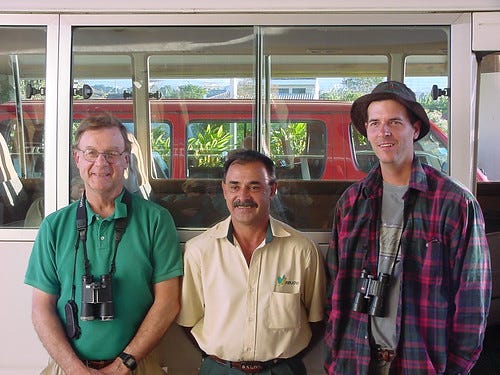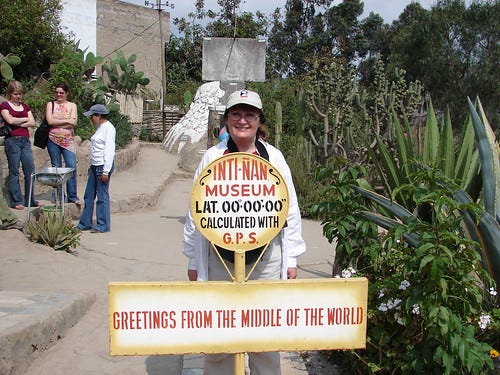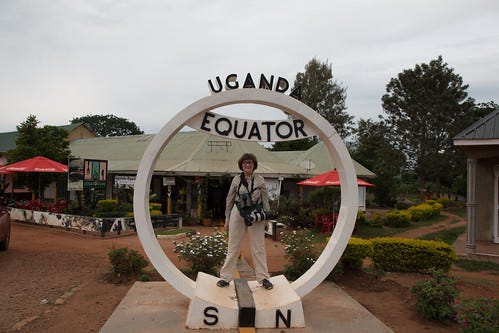Staying Healthy While Traveling
I've enjoyed birding trips all over thanks to the WHO, CDC, and NIH
(Listen to the radio version here.)
On January 1, 2001, I traveled outside the United States for the very first time. (Well, a quarter-century earlier, in 1976, I did go birding at Point Pelee in Ontario, not far from Detroit, but that hardly seemed like international travel—we didn’t need a passport to cross the border and weren’t even asked for identification.) Now, on 01/01/01, my aunt was sending me to my dream destination, Costa Rica.
My dear friend Mike Mulligan organized this trip and did a better job than anyone I’ve ever worked with to prepare those of us who had never traveled internationally before. Months before the trip, he insisted we each go to our doctor and verify that we had all the vaccinations we’d need—that would never have occurred to me.

The World Health Organization keeps up with infectious diseases worldwide, providing our own Centers of Disease Control and National Institutes of Health with up-to-date information about what problems we could encounter wherever we go, and what health issues might be on the horizon here in America. Based on my personal vaccination history and WHO, NIH, and CDC recommendations, the travel clinic at my healthcare provider gave me vaccinations for Hepatis A and B, tetanus, diphtheria, and typhoid; an antimalarial medication I had to take before and during the trip; and Cipro just in case I got a bacterial infection.
I had to pay for the travel clinic visit out-of-pocket—my insurance doesn’t cover that. For those who don’t have a travel clinic or who can’t afford it, the Centers for Disease Control website has an up-to-date “Travelers’ Health” page with necessary precautions for far-flung destinations. A visit to your family doctor for the recommended vaccinations will still be necessary.
Since that trip, I’ve managed over the years to get to Costa Rica three more times, Mexico, Guatemala, Panama, Cuba, Trinidad, Ecuador, Peru, Germany, Austria, Hungary, and Uganda, and before every trip, I’ve visited the travel clinic. Sometimes I’ve been completely caught up for what would be necessary based on my itinerary, sometimes I’ve needed boosters, and for one trip I needed a vaccination to protect me from yellow fever.

I also bring the regular medications I need, leaving home non-essentials like my usual daily multivitamins. I wasn’t on any routine prescription medications at all in 2001, but two decades, two heart attacks, and two bouts with cancer later, I must take several prescription meds each day, one of which is warfarin. Any blood thinner can cause dangerous bleeding if we’re in an accident, and what seems like even a very minor fall can be life-threatening if we hit our head. Bathtubs and showers are always dangerous and especially slippery in warm climates, so as a precaution, I now always bring my own bathmat, even on trips here in the States. I also always bring a walking stick for when we’re going to be somewhere that might be rocky or slippery—that was invaluable outside Nome, Alaska, when we hiked up the wet, slippery, treacherous trail to see the Bristle-thighed Curlew.
My watch, which I wear every day, has a tag with my name, home phone number, and “WARFARIN” so any first responders would hopefully notice right away that I’m on warfarin and inject me with Vitamin K to start my blood clotting again.
My itinerary next month includes one location where rabies is an issue, so this month I got two rabies vaccination shots. I’d have taken the nurse practitioner’s advice about this anyway, but one of my dearest friends recently had to be airlifted from Costa Rica after being bitten by a bat. No way would I want to deal with that when the preventative vaccination was so simple.
The CDC no longer recommends Cipro for travelers’ bacterial infections—this time I’m bringing azithromycin. Yesterday I took the last of four doses of an oral typhoid vaccine, and now I’m good to go!
The United States was one of the founding members of the World Health Organization in 1948, three years before I was born. I've always taken it, along with America's Centers for Disease Control and National Institutes of Health, for granted. I wonder who will be there to protect my children and Walter so they can enjoy as long and happy a life as I have.









Laura, once again, thank you for giving context to the world of birding. As you point out; the WHO, CDC, and NIH are valuable institutions and we rely on them as travelers and citizens. Participating in the WHO gave our country a voice in a world in which no country is isolated. We are healthier when we work together to stay healthy. Thank you for your insight.
What a great thing to be warned about the need for vaccines, etc. before your first trip abroad so you be on alert to check that out each time afterwards! A question I have been wanting to ask you: is it really safe to scare squirrels off with cayenne pepper because it won't hurt the birds?!